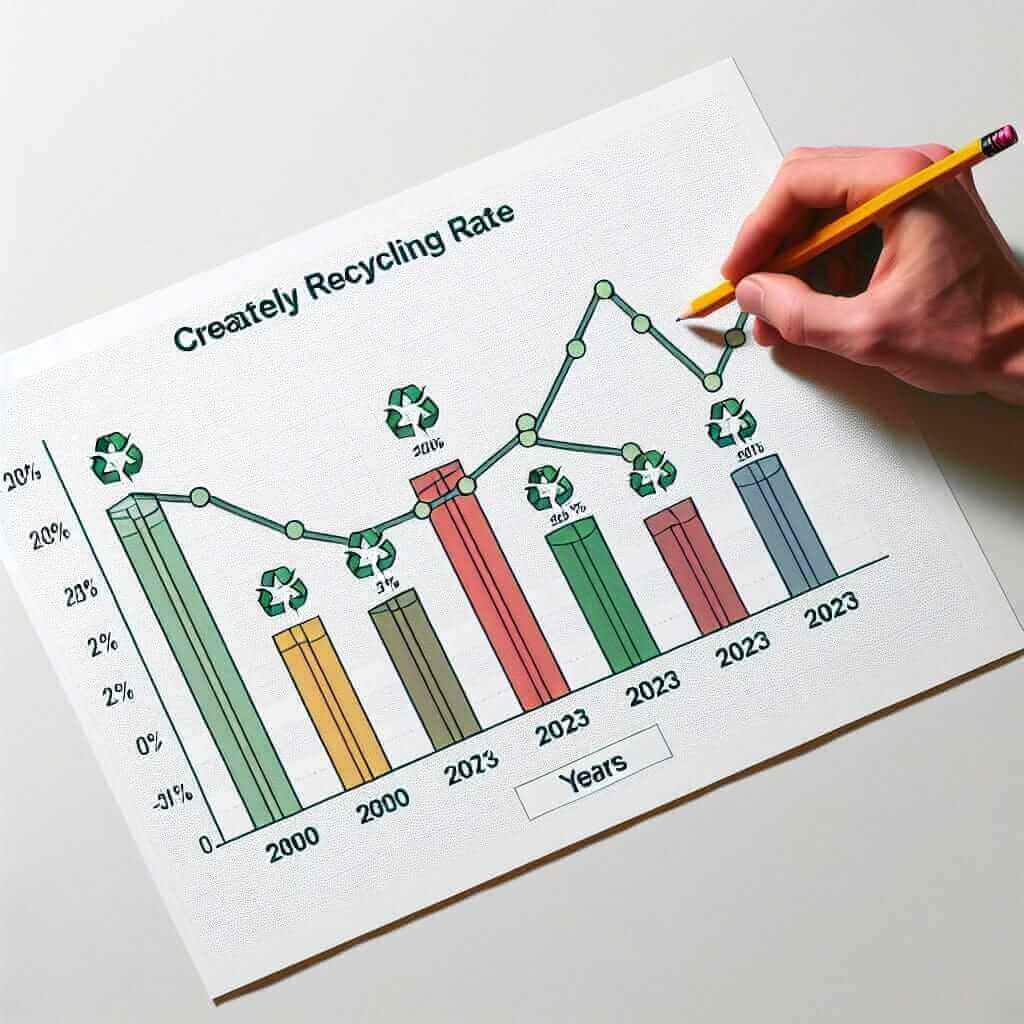Recycling rates have become a significant indicator of a country’s commitment to environmental sustainability. This topic frequently appears in the IELTS writing task 1, where students are required to interpret and analyze data presented in graphs, tables, or charts. In this lesson, we will explore how to tackle a writing task based on this subject effectively.
Understanding the Task
Task Analysis
For IELTS Writing Task 1, you might be given a line graph, bar chart, or table illustrating recycling rates in different countries over several years. Your task is to summarize the information by selecting and reporting the main features and making comparisons where relevant.
Sample Task
You should spend about 20 minutes on this task.
The chart below shows the recycling rates of four countries from 2000 to 2023.

Summarize the information by selecting and reporting the main features, and make comparisons where relevant.
Write at least 150 words.
Analyzing the Data
First, let’s examine the provided data and note any significant trends or patterns:
- Country A shows a steady increase from 35% in 2000 to 75% in 2023.
- Country B had fluctuations but generally rose from 40% in 2000 to 70% in 2023.
- Country C started at 50% in 2000 and dropped to 45% in 2023.
- Country D showed a consistent rise from 30% in 2000 to 60% in 2023.
Writing the Report
Introduction
Start by paraphrasing the task statement:
“The bar chart provided compares the recycling rates of four different countries over a period from 2000 to 2023.”
Overview
Give a general summary of what the data shows. Point out the main trends without going into too much detail:
“Overall, the recycling rates of most countries increased over the period, with Country A showing the most significant rise. In contrast, Country C was the only country that experienced a decline.”
Detailed Paragraphs
Paragraph 1
Discuss the details of the countries with rising recycling rates:
“Country A experienced a remarkable increase in its recycling rate, starting at 35% in 2000 and reaching 75% by 2023. Similarly, Country B’s recycling rate generally rose from 40% to 70%, despite some fluctuations. Country D also displayed a steady upward trend, increasing from 30% to 60% over the same period.”
Paragraph 2
Focus on the country with differing trends:
“In contrast, Country C saw a decrease in its recycling rate. Beginning at 50% in 2000, its rate dipped slightly to 45% by 2023, showing a downward trend unlike the other countries.”
Sample Writing
Here is a full example of how to write the report:
“The bar chart provided compares the recycling rates of four different countries over a period from 2000 to 2023.
Overall, the recycling rates of most countries increased over the period, with Country A showing the most significant rise. In contrast, Country C was the only country that experienced a decline.
Country A experienced a remarkable increase in its recycling rate, starting at 35% in 2000 and reaching 75% by 2023. Similarly, Country B’s recycling rate generally rose from 40% to 70%, despite some fluctuations. Country D also displayed a steady upward trend, increasing from 30% to 60% over the same period.
In contrast, Country C saw a decrease in its recycling rate. Beginning at 50% in 2000, its rate dipped slightly to 45% by 2023, showing a downward trend unlike the other countries.”
(160 words)
Key Vocabulary and Grammar Points
Vocabulary
- Fluctuation /ˌflʌk.tʃuˈeɪ.ʃən/ (noun) – an irregular rising and falling in number or amount.
- Remarkable /rɪˈmɑː.kə.bl̩/ (adjective) – worthy of attention; striking.
- Steady /ˈstɛd.i/ (adjective) – firmly fixed, constant, not subject to change or variation.
- Upward /ˈʌp.wərd/ (adjective) – moving towards a higher place or level.
- Decline /dɪˈklaɪn/ (verb) – become smaller, fewer, or less; decrease.
Grammar Points
- Paraphrasing: Use synonyms and restructuring sentences to avoid repetition.
- Comparative Structures: Use comparative phrases like “more significant,” “unlike,” “similarly,” to compare different data sets.
- Time Expressions: Phrases like “over a period from 2000 to 2023,” “by 2023,” help to clearly indicate time frames.
Tips for Success
- Understand the Data: Spend the first few minutes analyzing the data. Note the key trends and comparisons you will write about.
- Structure Your Report: Organize your writing into a clear structure: Introduction, Overview, Details, and Conclusion.
- Use Technical Vocabulary: Employ terms like “fluctuate,” “steadily increase,” “decline,” to describe trends precisely.
- Stay Within Word Count: Practice writing concisely to fit within the 150-word limit, but ensure clear and complete data description.
Conclusion
Writing about recycling rates in different countries requires a clear understanding of the given data and the ability to summarize significant trends concisely. By following a structured approach and using precise language, you can achieve a high band score in the IELTS writing task 1. Remember to practice regularly with different types of data to build confidence and proficiency.